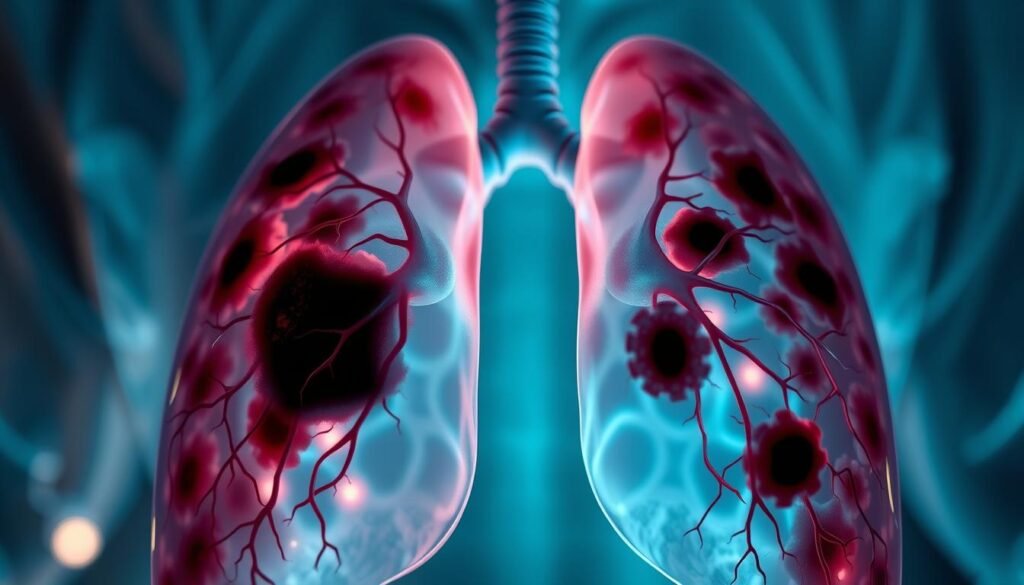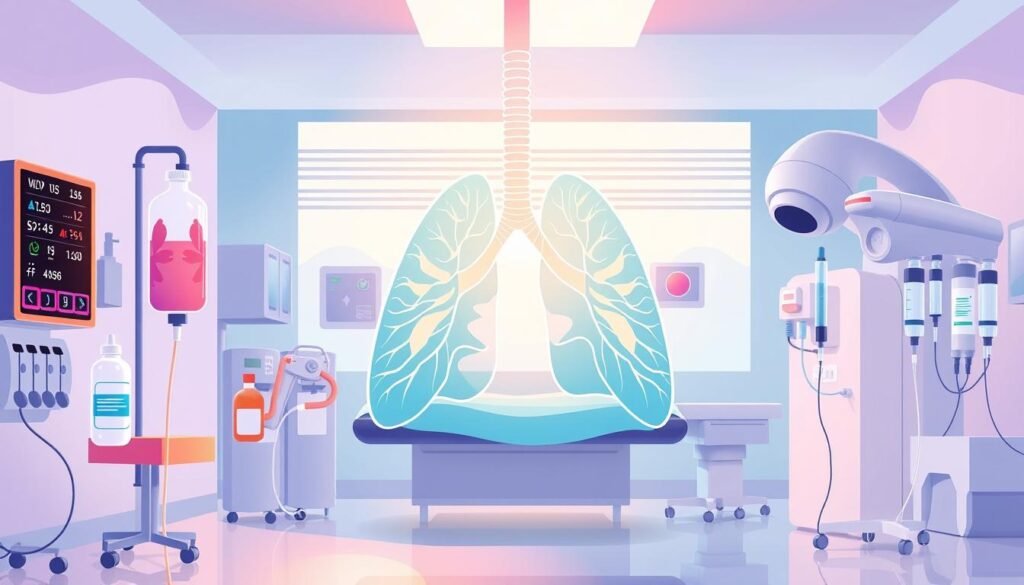The average five-year survival rate for stage IV lung cancer is low. For non-small cell lung cancer (NSCLC), it’s 9%. For small cell lung cancer (SCLC), it’s only 3%. These numbers show how serious stage IV lung cancer is. At this advanced stage, the cancer has spread to other parts of the body. Patients face tough challenges, including dealing with the diagnosis and exploring treatment options.
This article will explore stage IV lung cancer deeply. We’ll look at survival rates, symptoms, and types of lung cancer. We’ll also discuss resources to support patients and their families. Knowledge about advanced lung cancer can empower those affected. It can help improve their life quality and treatment results.
Key Takeaways
- Stage IV lung cancer indicates the cancer has metastasized beyond the lungs.
- The survival rate for stage IV NSCLC is approximately 9%, while for SCLC it is around 3%.
- Understanding the symptoms is crucial for timely management and care.
- Palliative care plays a vital role in enhancing the quality of life for patients.
- Various treatment options, including chemotherapy and targeted therapy, are available.
- Emotional and psychological support can significantly impact patient well-being.
What is Stage IV Lung Cancer?
Stage IV lung cancer is the most advanced type, meaning it has spread far from the lungs. It can reach distant organs like the brain, liver, or bones. According to the AJCC, this stage is considered “distant” and has a serious outlook.
The division into Stage 4A and 4B depends on how far the cancer has spread. Stage 4A involves cancer spreading to one other site, whereas 4B means it’s in multiple organs. This affects treatment options and survival chances.
Around 20% of lung cancer cases in the U.S. are stage IV. It’s crucial for patients to understand their lung cancer definition and what it means for them. They need to discuss treatment plans and challenges with their doctors.
Early stage lung cancer might be managed with surgery, but stage IV is different. The treatment options change drastically. For more info on lung cancer stages, visit lung cancer staging.
Symptoms of Stage IV Lung Cancer
It’s very important to know the symptoms of stage IV lung cancer for early diagnosis and treatment. This last stage of the disease comes with many symptoms that can change a patient’s life. Knowing both common and less common symptoms is key to getting fast medical help.
Common Symptoms
Many symptoms are reported by those with stage IV lung cancer, such as:
- Persistent cough
- Coughing up blood (hemoptysis)
- Chest pain, worsening with breathing or coughing
- Shortness of breath
- Fatigue
- Loss of appetite and weight loss
These symptoms often get worse as the disease moves forward. It’s crucial for patients to tell their doctors about any new or changing symptoms.
Secondary Symptoms
Other symptoms can appear if the cancer spreads to more parts of the body. These include:
- Headaches or neurological issues when cancer reaches the brain
- Jaundice (yellowing of the skin and eyes) if it affects the liver
- Bone pain if cancer has spread to the bones
Finding these symptoms early in stage IV lung cancer can lead to better care plans. X-rays, CT scans, and biopsies are used to check the spread of the disease and plan treatment.
Types of Lung Cancer: NSCLC vs. SCLC
Lung cancer mainly has two types: non-small cell lung cancer (NSCLC) and small cell lung cancer (SCLC). Knowing these types helps doctors diagnose and treat patients.
Overview of Non-Small Cell Lung Cancer (NSCLC)
Non-small cell lung cancer represents around 80 to 85% of all lung cancer cases. It is split into subtypes like adenocarcinoma, squamous cell carcinoma, and large cell carcinoma. Adenocarcinoma, which is the most common, comes from mucus-making cells in the lungs.
Squamous cell carcinoma starts in the flat cells lining the bronchial tubes, often linked to smoking. Large cell carcinoma has bigger cells, grows quickly, and spreads fast. Other less common types are adenosquamous and sarcomatoid carcinoma. NSCLC can spread to lymph nodes or other organs as it grows.
Overview of Small Cell Lung Cancer (SCLC)
Small cell lung cancer makes up about 15 to 20% of lung cancer cases. It’s closely tied to smoking. This cancer grows quickly and spreads early, making its treatment tough.
SCLC is divided into limited and extensive stages, rather than by numbers like NSCLC. The main treatment is chemotherapy, which works well but often the cancer comes back. Knowing how SCLC spreads fast shows why quick diagnosis and treatment are crucial.
For more details on lung cancer types, including rare ones, check out this helpful link.
Understanding Metastatic Lung Cancer
Metastatic lung cancer means the disease started in the lungs and moved to other body parts. This can affect important organs like the brain, liver, and bones, making treatment harder.
The outlook for those with metastatic lung cancer is often worrying. The five-year survival rate for stage IV non-small cell lung cancer is only 8 percent. For small cell lung cancer, the survival rate drops to 3 percent for cases that have spread far.
However, if the lung cancer has spread to fewer places, things might be a bit different. This is known as oligometastatic lung cancer. It usually involves less than five sites. Treatments like targeted drugs and radiation can be used. The treatment depends on the patient’s health, past cancer treatments, and how fast the cancer is spreading.
It’s vital to know how metastatic lung cancer works to care for patients better. Treatments like chemotherapy and immunotherapy can lessen symptoms. They can also improve life quality despite the cancer spreading widely.

Prognosis of Stage IV Lung Cancer
The outlook for stage IV lung cancer greatly affects treatment choices. Knowing the survival rates helps patients and families deal with this tough disease. Looking at the stats provides clear expectations for the future.
Survival Rates
The five-year survival rate for stage IV lung cancer is quite low. For those with non-small cell lung cancer (NSCLC), it’s about 9%. However, small cell lung cancer (SCLC) has worse outcomes, with a rate of about 3%. These numbers show how hard it is to deal with stage IV lung cancer.
| Cancer Stage | NSCLC Survival Rate | SCLC Survival Rate |
|---|---|---|
| Localized | 65% | 30% |
| Regional | 37% | 18% |
| Distant (Stage IV) | 9% | 3% |
| All Stages Combined | 28% | 7% |
Factors Affecting Prognosis
Many factors impact stage IV lung cancer outcomes. Age, health, and genetic mutations in the cancer are key. Also, the type of lung cancer, NSCLC or SCLC, affects survival chances.
New treatment strategies could improve outcomes. Knowledge of these factors lets doctors give better info, helping patients make choices. As research grows, so does the hope for higher survival rates in the future.
Lung Cancer Treatments for Stage IV Patients
Treating stage IV lung cancer focuses on increasing life expectancy and comfort. It often combines different treatments, based on the patient’s needs. Systemic treatments like chemotherapy and immunotherapy are key. They work to control cancer cells all over the body.
Systemic Treatments: Chemotherapy and Immunotherapy
For stage IV non-small cell lung cancer, chemotherapy is critical, especially without certain genetic mutations. Common drug pairs include:
- Cisplatin or carboplatin with gemcitabine
- Cisplatin or carboplatin and docetaxel
- Carboplatin and paclitaxel
Immunotherapy is also a major player. It gives hope to patients not helped by conventional methods. Drugs like pembrolizumab, atezolizumab, and nivolumab, often with ipilimumab, offer new doors.
Targeted Therapy Options
Certain patients might benefit from targeted therapy. This depends on their cancer’s genetic makeup. For instance:
- EGFR-positive tumors may be treated with erlotinib, gefitinib, or osimertinib.
- ROS1-positive tumors could be helped by crizotinib.
- Sotorasib works against KRAS G12C-positive non-small cell lung cancer.
- BRAF V600E positive cancer might improve with dabrafenib and trametinib.
These treatments focus on hitting cancer cells specifically, saving normal tissues. This results in fewer side effects than typical chemotherapy.
Palliative Care Strategies
Palliative care is crucial for handling stage IV lung cancer. It aims to manage symptoms and improve life quality. It includes:
- Endobronchial therapies for tumor blockages.
- Comfort-focused pain management.
- Radiation therapy for symptom relief from bone or brain metastases.
The main aim is improving patients’ lives, not curing the disease. It ensures a fuller life during the treatment period.

The Role of Palliative Care in Stage IV Lung Cancer
Palliative care is key for people with stage IV lung cancer. It focuses on improving life quality during treatment. This care helps ease symptoms like pain and breathing issues. It also supports emotional and mental health. By starting palliative care early, medical teams create a caring space. This space respects a patient’s comfort and choices.
More lung cancer patients are now getting palliative care. Referrals rose from 3% in 2001 to over 30% in 2013. However, only about 25% of advanced lung cancer patients used outpatient palliative care. When referred soon after diagnosis, patients better understand what to expect. This helps them make informed choices and plans.
Palliative care benefits are clear. It brings better life quality, less depression, and fewer harsh treatments at life’s end. For instance, regular care focused on easing symptoms reduces distress a lot.
The approach of palliative care covers all bases. It includes pain control, dietary advice, emotional backing, and therapies like massage. You can get palliative care in hospitals, clinics, or at home. This makes sure patients get the support they need.
To learn more about palliative care’s role in stage IV lung cancer, check this resource on palliative care benefits. It aims to ease suffering and boost life quality. It helps patients face the tough battle against cancer better.
Support for Patients and Families
Dealing with Stage IV lung cancer is tough for patients and families. Providing strong emotional support helps ease the mental strain of this diagnosis. Through effective communication and counseling, resilience and well-being are boosted. With professional advice and solid support networks, people can handle their situation better.
Emotional and Psychological Support
Patients with lung cancer go through many emotions. Fear, anxiety, and depression can change their life quality. Support from professionals, like oncology social workers, is crucial. CancerCare offers some financial help, easing worries about money. This lets families focus on feeling better, not finances. Peer support connects patients with others who have been there. It opens doors to understanding and healing.
Support Groups and Resources
There are many resources for lung cancer support. Groups like LUNGevity and CancerCare provide key information and community links. The LUNGevity Helpline, at 844-360-LUNG (5864), offers personal help. Workshops in English and Spanish teach coping skills. Services like Magnolia Meals at Home deliver meals to patients, easing treatment stress.
| Support Resource | Description | Contact/Website |
|---|---|---|
| LUNGevity Lung Cancer Helpline | Personalized support and guidance for lung cancer patients. | 844-360-LUNG (5864) |
| CancerCare | Financial assistance and emotional support for eligible families. | cancercare.org |
| Magnolia Meals at Home | Meal delivery service for patients in specific areas. | magnoliasofct.com |
| Connect Education Workshops | Educational workshops led by oncology experts. | cancercare.org |

Managing Lifestyle Changes After Diagnosis
After finding out you have stage IV lung cancer, many things in your life might change. You might have to change how you eat, what you do each day, and how you spend your time. Talking to doctors and other health experts is key. They help make a plan that’s just for you.
Good nutrition is very important when dealing with cancer. Eating right can help your treatment work better and make you feel good. Let’s look at some key changes you can make:
- Incorporating a balanced diet rich in fruits and vegetables to strengthen the immune system.
- Increasing physical activity to improve mood, reduce fatigue, and maintain a healthy weight.
- Quitting smoking for immediate health benefits and improved lung function.
- Establishing a support system comprising family, friends, and other cancer patients.
| Lifestyle Change | Benefits |
|---|---|
| Good Nutrition | Helps maintain strength and fight infections |
| Regular Exercise | Reduces fatigue and boosts mood |
| Smoking Cessation | Normalizes blood pressure and lowers chronic disease risks |
| Emotional Support | Adds resilience and coping strategies |
It’s easy to feel lost after a tough diagnosis. But taking control of your health can make a big difference. Making good choices can ease some treatment side effects. It’s also important to keep seeing your healthcare team regularly. They will support you and watch over your health as you adjust.
Conclusion
Stage IV lung cancer is very advanced, meaning the cancer has spread from the lungs. Knowing about symptoms and treatments is key to help patients and their families live better. Even though lung cancer is tough to beat, new treatments bring hope. People can choose from chemotherapy, immunotherapy, or targeted therapy, each with different benefits.
Patients should talk openly with their doctors to choose the best treatment. These talks can make a care plan that focuses on comfort and respect. Many find adding palliative care to their plan helps with the challenges of late-stage lung cancer, even if it doesn’t extend life.
Facing stage IV lung cancer also means dealing with emotional stress. Support groups, counseling, and family support can reduce feelings of loneliness and fear. Knowing about the TNM staging system helps in making informed choices. These efforts help build strength while facing the difficulties of stage IV lung cancer.